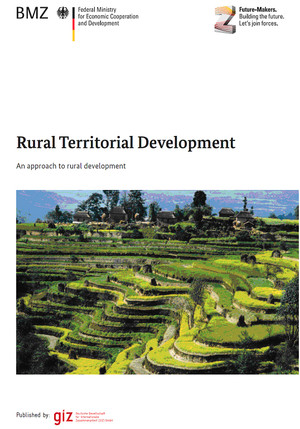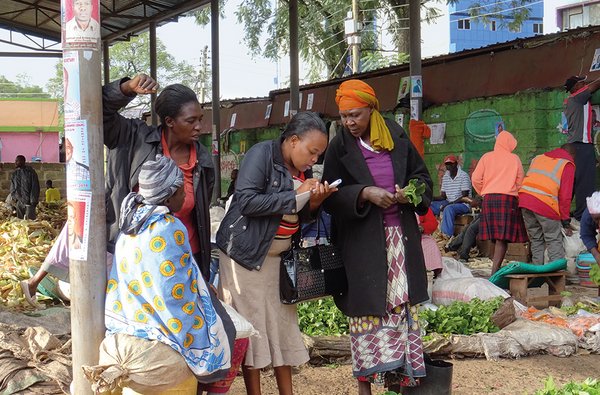- Share this article
- Subscribe to our newsletter
Remembering forgotten crops – developing new value chains
World-wide, the challenge is emerging to provide a growing population with the right amount of food at the right time while making sure that diets are nutritious and of high quality. Large shares of the population in developing economies continue to be confronted with insecure food supplies and, on top of this, malnutrition persists. Moreover, growing economies and low-to-middle income countries (LMIC) are experiencing an influx of non-communicable diseases (NCDs) such as diabetes, obesity and cardio-vascular disease. Therefore, agriculture and biodiversity’s role in fighting malnutrition, food insecurity and growing levels of NCD incidence has gained a key status in the Sustainable Development Goals (SDGs). Next to these challenges, the SDGs also highlight the importance of biodiversity for humans. This is where the concept of agrobiodiversity – practising agriculture while maintaining biodiversity – comes in. Despite a plethora of edible plants that are known, human diets are relying more and more on a limited array of crop species to satisfy nutritional needs, resulting in a loss of diversity on fields – and on plates. This leads us to the proposition to realise the chances of reincorporating “forgotten or orphaned”, so-called underutilised crops in people’s menus and on farmers’ fields.
Big potential, huge challenges
At a symposium held during the Elsevier International Conference on Global Food Security in Cape Town, South Africa, in December 2017, the comparative advantages of orphan crop value chain development (VCD) as a strategic means towards improved food and nutrition security were discussed. The symposium concentrated on what VCD interventions might be the “right” or necessary ones to foster a sustainable uptake of underutilised crops and what concrete actions or solutions could help bring back orphaned crops to people’s plates. Researchers from Kenya, Germany and the USA presented their latest research results on African Indigenous Vegetables (AIVs) – and, more specifically in this context, on leafy green vegetables in Kenya (see Box).
LEAFY GREEN VEGETABLES AND VALUE CHAIN DEVELOPMENT (VCD)
African Indigenous Vegetables (AIVs) are found across sub-Saharan Africa, but in our research we focus on leafy green vegetables commonly eaten in East African countries such as amaranth and cowpea leaves (Vigna unguiculata), African nightshade (Solanum villosum), spider plant (Cleome gynandra), Ethiopian kale (Brassica carinata), jute mallow (Corchorus olitorius), slenderleaf (Crotoslaria spp.), etc. These crops have been gaining attention in sub-Saharan Africa as an alternative crop to “exotic” or introduced horticultural crops such as collard greens, green beans or tomatoes. AIVs have the potential to improve diets, diversify farm production and generate income due to a growing yet unsatisfied local demand. Nevertheless, VCD of underutilised crops like AIVs is confronted with significant challenges such as perception problems, a lack of holistic research, poor policy frameworks and weak marketing strategies. Given such multiple challenges, only a comprehensive VCD approach is able to address the obstacles found at each stage of the value chain – as the motto “from farm to plate” suggests.
Underutilised crops are above all seen as important for food and nutrition security because they enable a diversification of food and nutrient sources, i.e. a holistic approach to human diets. In the past, as Michael Krawinkel, Professor at Justus Liebig University Giessen, Germany, explains, food and nutrition security strategies targeted calorie intake, and potential “nutrient gaps” were closed with supplementary feeding or fortification. Today, diversified diets, especially those containing fruits and vegetables on a regular basis, are widely viewed as a better way to close this gap (also see Figure below).

What is happening to our diets?
To harness this potential, it is essential to build consumer awareness and sensitise people towards taking up fruit and vegetable-rich diets. The empowerment of consumers to make informed decisions to become food-sovereign stands starkly in contrast to growing consumer dependency on media and advertisements promoting the consumption of unsustainably produced and unhealthy food.
According to Elizabeth Mitcham from University of California, Davis, USA, more than half of the global population do not consume adequate amounts of fruit and vegetables on a daily basis. People tend to rely heavily on a small array of crops compared to the large variety of edible plants. Studies suggest a strong dietary diversity development linkage, showing a positive relationship between the availability of food groups and nutritional, health and development outcomes. Nonetheless, one growing problem spread particularly in urban centres of low and middle income countries is the dramatic increase in the consumption of processed foods as urban dwellers become more affluent. For rural areas, studies in Tanzania demonstrated that an increase in smallholder horticultural crop production and behaviour change communication can generally increase the consumption of AIVs.
An entrepreneurial gambit for farmers?
Integrating resource-poor smallholder farmers into growing orphan crops like AIVs holds the potential of addressing income generation in rural areas and nutrition challenges in urban areas. Willis Kosura, a professor at the University of Nairobi, Kenya, examined the positive link between the demand for AIVs and the level of knowledge of their nutritional and health benefits. Yet, local AIV supply fails to keep pace with the growing demand. Barriers for farmers to adopt AIV production include poor infrastructure, lack of government involvement, and prevailing negative consumer perceptions of AIVs as “poor man’s food”. Kosura’s field research in Western Kenya suggests that awareness creation for the market potential of AIVs, improving information access and collective bargaining through farmer groups have the power to develop both the production and marketing ends of the AIV value chain.
Considering all dimensions of sustainability
When considering the impacts of climate change and ecological sustainability, there are many entry points along the value chain of AIVs to turn it into a more sustainable one. Starting at the production level, the concept of sustainable intensification of farming provides a general framework aiming to produce a maximum output by optimising climate and livelihood trade-offs. According to Barnabas Kurgat, a PhD student at the Centre for Rural Development (SLE) in Berlin/Germany, nitrogen fertiliser efficiency is a major hotspot in mitigating greenhouse gas emissions from AIV value chains. In his studies, a mixed fertilisation strategy with the combined use of manure and synthetic nitrogen proved to have the best economic and ecological trade-off. Still to this day, small-scale irrigation and improved seed varieties are rarely used, although they have the potential of jumpstarting the Kenyan AIV value chain. In addition, increased on-farm agrobiodiversity holds much potential for smallholder AIV producers. The climate change adaptation and ecological sustainability of AIV value chains research group at the Centre for Rural Development (SLE) has found out that AIV commercialisation need not mean a loss in agrobiodiversity. Commercial Kenyan AIV farmers in fact have the most diversified AIV species production portfolio, suggesting that specialised AIV farmers also see a potential in growing a range of AIVs.
But if there is so much potential for forgotten crop VCD to let producers make their businesses more economically and ecologically sustainable, why aren’t they picking it up? Focus group discussions and household survey analysis have revealed that Kenyan AIV smallholders often have low adaptive capacities. Adaptation gaps vary, but particularly for rural areas, too little income diversification and financial management as well as limited access to high value/formal markets are major constraints.
 How do we make sure oprphan crops get to the plate?
How do we make sure oprphan crops get to the plate?
Although AIVs are indeed found to be climate-resilient and socially inclusive, further challenges in the mid- and down-stream segments of the value chain can hinder unlocking this potential. Challenges more on a macro-level, such as poorly organised governance of markets, land and services, increase losses of AIV in the mid-stream value chain segments. Further down-stream, at the consumer level, demand management promoting the concept of diets rich in healthy fruit and vegetables replacing a trend towards animal protein-intense diets could help uplift the upper end and the sustainability of the AIV value chain. To make it sustainable, it is paramount to achieve sustainability along the entire AIV value chain – from consumers to traders and processors all the way to producers.
Making post-harvest losses tangible
In comparison to cereals or tubers, leafy horticultural crops such as AIVs are highly perishable and are thus subject to heavy post-harvest losses. Preventing these losses is growing in importance not only in industrialised countries, but also in developing economies, as food losses greatly contribute to food insecurity, poverty, slow economic growth and climate change. Research experiments conducted in Kenya by Elisha Gogo of Humboldt University Berlin, Germany, have shown that losses between harvesting up until marketing can even rise to 50 per cent. Not only is a loss of quantity detrimental to upward mobility, but loss of nutritional food quality is also a huge problem for society as a whole. Poor handling along the value chain can indeed significantly decrease the precious nutritive value (e.g. provitamin A, iron, zinc) of AIVs, which is beneficial for consumer health.
To confront this pitfall, appropriate post-harvest technologies can truly contribute to preventing losses. To achieve this, we need to revolutionise packaging and handling. Farmers and traders in Kenya commonly pack or even stuff large quantities of the fragile AIV into large bags. However, the full extent of the causes and magnitude of post-harvest losses is still not fully uncovered. In a stakeholder experiment, to create awareness for the impacts of post-harvest losses, it became evident that as soon as the economic losses were broken down into actual costs and made visible per value chain step (at harvest, after harvest, at market), farmers and traders started to grasp the magnitude and importance of post-harvest handling for their enterprise. Making economic impacts of post-harvest losses observable at the micro-level could even also help promote the introduction of new emerging post-harvest technologies, such as new packaging material (modified atmosphere packaging, biodegradable packaging) or UV-C treatment at the market level.
Let’s talk about nutrition
Coming to the last stage of an orphan crop value chain, we encounter an important stakeholder – the consumer. Developing this stage of the value chain is crucial not only to influencing supply (AIV farmers) and demand (AIV consumers), but also in addressing consumer health issues. The paramount prerequisite is to ensure that there is a demand for an orphan crop like AIV, so it makes sense for farmers to endeavour in uptake of AIV production. One key to driving demand for forgotten crops like AIV is banking on their nutritional value. In Kenya, consumers appear to be very much aware of the nutritional benefits of AIV and are commonly eager to buy them for this reason. A research team led by Susanne Huyskens-Keil from Humboldt University Berlin investigated the impact of different handling and preparation methods on the nutritional value of AIVs. Surprisingly, the studies reveal that AIV sold in Kenya at open markets retained higher mineral composition as well as antioxidative compounds than those sold at supermarkets. Another striking result is that AIV processing (cooking and drying) does not necessarily have a detrimental effect on the nutritional content. For example, from her experiments, PhD candidate Grace Odongo concludes that the AIV Ethiopian kale (Brassica carinata) is still able to protect against aflatoxin-induced DNA damage in liver cells after cooking. Aflatoxin poisoning through food consumption and its damage to the liver is indeed a highly relevant topic in developing and upcoming economies like Kenya. A lack of institutionalised quality control often entails food infested with the aflatoxin-causing fungi making it onto consumers’ plates. Studies by Eliud Wafula from the Max Rubner Institute, Karlsruhe, Germany suggest that AIV processing through fermentation also shows potential to prevent the loss of nutritional compounds.
An orphan crop like AIV starting to enjoy a surge in popularity based on its nutritional benefits gives us reason to consider it at least in its home region as an undiscovered so-called “super food”. Further post-harvest treatment and processing innovations, e.g. deriving extracts or powder for the development of new functional food, might be additional steps to secure the nutritional benefits and create new marketing strategies for this underutilised crop.
Caroline Moraza and Dr Silke Stöber are research associates at the Centre for Rural Development (SLE) at Humboldt-Universität zu Berlin.
Zoltan Ferenczi is a research associate and Wolfgang Bokelmann is a professor at the Albrecht-Daniel-Thaer Institute of Horticultural and Agricultural Sciences at Humboldt-Universität zu Berlin.
References and further reading:
Hortinlea
http://www.hortinlea.org
Kurgat, B.K., Stöber, S., Mwonga, S., Lotze-Campen, H. and Rosenstock, T.S. (2018), Livelihood and climate trade-offs in Kenyan peri-urban vegetable production. Agricultural Systems, 160, pp.79-86.
Gogo, E.O., N. Förster, D. Dannehl, L. Frommherz, B. Trierweiler, A.M. Opiyo, Ch. Ulrichs, and S. Huyskens-Keil 2018. Postharvest UV-C application to improve health promoting secondary plant compound pattern in vegetable amaranth. Innovative Food Science and Emerging Technologies, 45:426-437.
Gogo, E.O., Opiyo, A.M., Ulrichs, C. and Huyskens-Keil, S., 2017. Nutritional and economic postharvest loss analysis of African indigenous leafy vegetables along the supply chain in Kenya. Postharvest Biology and Technology, 130, pp.39-47.
Gogo, E.O.; Opiyo, A.M.; Ulrichs, C. and Huyskens-Keil, S. 2016. Postharvest treatments for African leafy vegetables for food security in Kenya: A review. African Journal of Horticultural Science 9: 32 – 40.
Odongo, G.A., Schlotz, N., Herz, C., Hanschen, F.S., Baldermann, S., Neugart, S., Trierweiler, B., Frommherz, L., Franz, C.M., Ngwene, B. and Luvonga, A.W., 2017. The role of plant processing for the cancer preventive potential of Ethiopian kale (Brassica carinata). Food & nutrition research, 61(1), p.1271527.
Stöber, S., Chepkoech, W., Neubert, S., Kurgat, B., Bett, H. and Lotze-Campen, H., 2017. Adaptation pathways for African indigenous vegetables’ value chains. In Climate Change Adaptation in Africa (pp. 413-433). Springer, Cham.
Wafula, E.N., Franz, C.M., Rohn, S., Huch, M., Mathara, J.M. and Trierweiler, B., 2016. Fermentation of African indigenous leafy vegetables to lower post-harvest losses, maintain quality and increase product safety. African Journal of Horticultural Science, 9.





Add a comment
Be the First to Comment